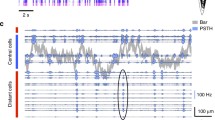Summary
A feature extractor for a pattern recognizer which can effectively process curvilinear drawings has been synthesized and simulated on a digital computer.
The design of the network was suggested by the visual system of higher animals — especially the structure of the receptive fields of cortical neurons. This feature extractor is a multilayered parallel network composed of “analog threshold elements”. It consists of six layers in cascade. The first layer is a two-dimensional array of photoreceptors. The second layer is a contrast-detecting layer, each element of which has an “on”-center-type receptive field. The third one is a line-detecting layer. An element of this layer corresponds to a “simple” cortical cell, and responds to lines whose orientation is proper for the element. Each element has a receptive field consisting of an elongated excitatory region flanked on either side by inhibitory regions. The fourth layer is also a line-detecting layer, but each element, which corresponds to a “complex” cell, is not sensitive to the exact position of the line. An element of the fifth layer, which may correspond to a “hypercomplex” cell, responds when the line detected in the preceeding layer is curved. In the final layer, the curvature of the line is detected regardless of the orientation of the line, that is, an element of this layer gives an output approximately proportional to the curvature of the line presented in its receptive field.
Similar content being viewed by others
References
Attneave, F.: Some informational aspects of visual perception. Psychol. Rev.61, 183–193 (1954).
Fukushima, K.: Visual feature extraction by a multilayered network of analog threshold elements. IEEE Trans. Systems Science and CyberneticsSSC-5, 322–333 (1969).
Hubel, D. H., Wiesel, T. N.: Receptive fields of single neurones in the cat's striate cortex. J. Physiol. (Lond.)148, 574–591 (1959).
— —: Integrative action in the cat's lateral geniculate body. J. Physiol. (Lond.)155, 385–398 (1961).
Hubel, D. H., Wiesel, T. N.: Receptive fields, binocular interaction and functional architecture in the cat's visual cortex. J. Physiol. (Lond.)160, 106–154 (1962).
— —: Receptive fields and functional architecture in two non-striate visual areas (18 and 19) of the cat. J. Neurophysiol.28, 229–289 (1965).
Kuffler, S. W.: Discharge patterns and functional organization of mammalian retina. J. Neurophysiol.16, 37–68 (1953).
Ratliff, F.: Mach bands: Quantitative studies on neural networks in the retina. San Francisco: Holden-Day 1965.
Watanabe, A., Hiwatashi, K., Hatanaka, S., Tanaka, T.: Study of human gazing points on two-dimensional patterns [in Japanese]. Technical J. of Japan Broadcasting Corporation17, 4–20 (1965).
Author information
Authors and Affiliations
Rights and permissions
About this article
Cite this article
Fukushima, K. A feature extractor for curvilinear patterns: a design suggested by the mammalian visual system. Kybernetik 7, 153–160 (1970). https://doi.org/10.1007/BF00571695
Received:
Issue Date:
DOI: https://doi.org/10.1007/BF00571695




